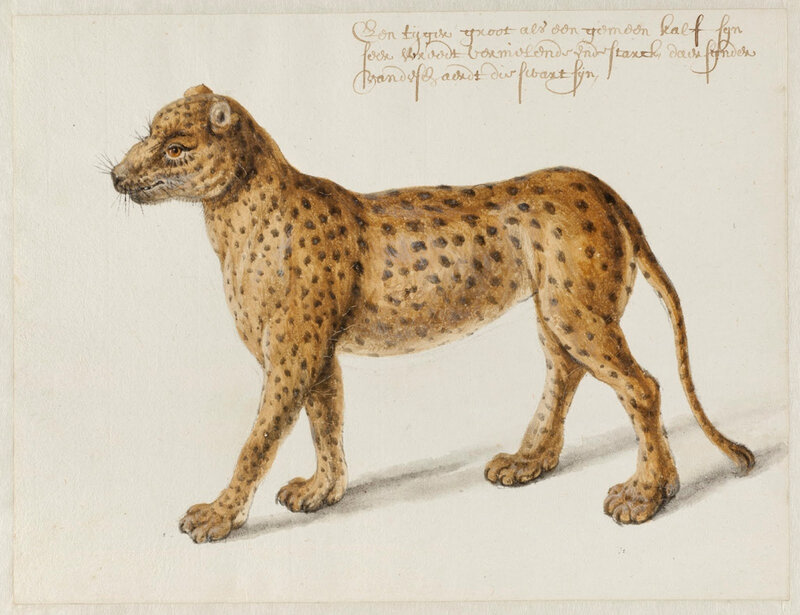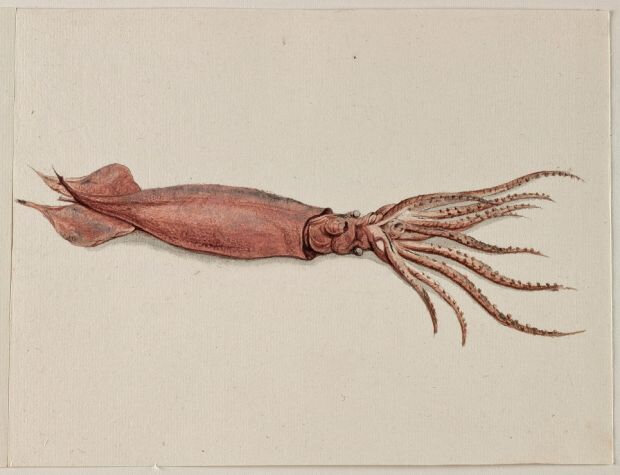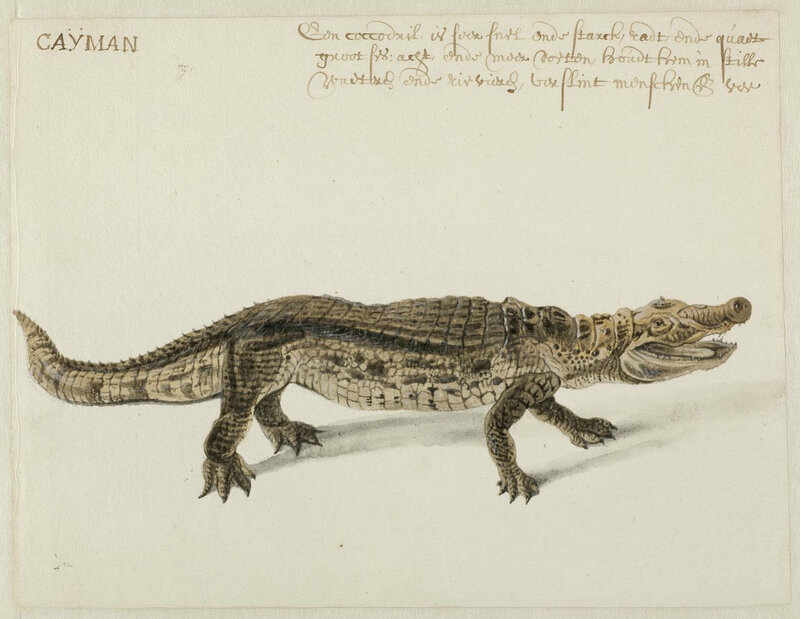The National Gallery of Ireland opens a unique exhibition of animal drawings by Dutch artist Frans Post
Frans Post, Panthera onca (Linnaeus, 1758). Watercolour and gouache in shades of yellow, brown, and black, with pen and black ink, over graphite. © Noord-Hollands Archief, Haarlem.
DUBLIN.- For the first time in Ireland, from 8 September – 9 December 2018, the National Gallery of Ireland presents a unique show of animal drawings by Dutch artist Frans Post (1612-1680). Admission is free. Post spent 7 years in Brazil, from 1637 to 1644, where he documented the plants and animals of the Dutch colony for its Governor-general Johan Maurits (1604-1679). This fascinating collection of Post’s unsigned drawings lay in a Haarlem archive for over 3 centuries before its rediscovery in 2010. Brazil inspired Post after his return to the Netherlands in 1644, where he produced and sold Brazilian-themed landscapes, which include many animals that correspond to the drawings on show here. Curious Creatures – Frans Post & Brazil includes 2 key paintings by Post. Specimens on loan from the Natural History Museum allow visitors to see animals from the artworks, in 3D.
An extraordinary discovery was made in 2010 by Dr Alexander de Bruin of the Noord-Hollands Archief – a Dutch Archive - in Haarlem, during an inventory of its holdings. It was long suspected that Post based his Brazilian landscape paintings on original drawings of flora and fauna. However, until this recent discovery, not a single animal or plant study from his hand was known. Many of the animals depicted in this cache of rediscovered drawings also clearly relate to those animals portrayed in his paintings.
Frans Post (1612-1680), Alpaca or Llama. © Noord-Hollands Archief, Haarlem
Curious Creatures – Frans Post & Brazil showcases these 34 previously unknown animal studies. The drawings on display include depictions of a white-lipped peccary, a porcupine, a giant anteater, a sloth, and a water opossum. The drawings within this collection include both graphite studies and more finished gouaches, of such animals as a South American Tapir, a Jaguar, a Neon Flying Squid with its Tentacles, an Alpaca or Llama, and a Cayman.
In relation to these rediscovered drawings, exhibition curator Niamh MacNally said: “This cache of animal drawings provides the missing link between Post’s seven-year Brazilian adventure and the paintings replete with exotic creatures that he produced on his return to Haarlem. The studies, in particular the finished gouaches, include amusing inscriptions which note the size, friendliness, dangers, and edibility of the creatures depicted. To make sense of these ‘curious creatures’, some of the inscriptions draw comparisons with Dutch animals. Such observations offer a glimpse into the astonishment that the artist must have felt on encountering these strange species for the first time.”
Frans Post (1612-1680), Neon Flying Squid with its Tentacles. © Noord-Hollands Archief, Haarlem
Post’s animal drawings have been complemented by 3 of the artist’s key works - his masterpiece View of Olinda, Brazil, 1662 (Rijksmuseum, Amsterdam), an important autograph drawing of a Sugar Mill (Atlas Van Stolk, Rotterdam), and the Gallery’s own oil painting Brazilian Landscape with Sugar Mill, 1660s (NGI.847). These works give an insight into how the artist both engaged with and immortalized the New World for a curious European audience.
Niamh MacNally comments: “The Gallery’s painting includes the highest number of animals corresponding to those appearing in Post’s recently found drawings – 9 in total. In the foreground, a plethora of animals including an alligator, armadillos, anteaters and a monkey are depicted. Regarded as one of the richest displays of exotic animals in any seventeenth-century European oil painting, our work has been described as a ‘Noah’s Ark’ by Frans Post scholars Pedro and Bia Corrêa do Lagos.“
This display is complemented by a small exhibition catalogue.
8 September–9 December 2018. Admission free.
Frans Post (1612-1680), 'South American Tapir' (Tapiris terrestris), (around 1637-1644). Watercolour and gouache with pen in black; translated inscription: ANTES // Great as a calf, live int water-using opt lant. Noord-Hollands Archief, Haarlem inv.nr. 53004658_02. © Haarlem, Noord-Hollands Archief
Frans Post (1612–1680), Caiman, (around 1637-1644). Watercolour and gouache with pen in black; translated inscription: CAIJMAN // A coccodril's overseer fast income Starck, rad, andthe quaet / large ses: overnight more feet, keeps him in silent. Noord-Hollands Archief, Haarlem inv.nr. 53004652_02. © Haarlem, Noord-Hollands Archief
Frans Post (1612-1680), Frans Post (1612–1680), Moustached Guenon, watercolor and gouache, with pen and black ink, over graphite, c. 1637–1644, translated inscription: A blue-nosed monkey from Angola, one and a half feet large, are very angry and malicious. Noord-Hollands Archief, Haarlem inv.nr. 53004665. © Noord-Hollands Archief, Haarlem.
Frans Post (1612–1680), Capybara, watercolor and gouache, with pen and black ink, c. 1637–1639; translated inscription: CAPYBARA. A water pig, as large as a small pig, lives in water as well as on land, eats fish and grass. Noord-Hollands Archief, Haarlem inv.nr. 53004657_02. © Noord-Hollands Archief, Haarlem.
Frans Post (1612–1680), Southern Tamandua, or Lesser Anteater. © Noord-Hollands Archief, Haarlem.
Frans Post (1612–1680), Crab-Eating Fox. © Noord-Hollands Archief, Haarlem.
Frans Jansz Post, View of Olinda, Brazil, 1662. © Rijksmuseum, Amsterdam
Frans Post (1612-1680), Brazilian Landscape, 1660s. Oil on wood panel, 48.3 x 62.2 cm. Photo © National Gallery of Ireland NGI. 2008.12.

/https%3A%2F%2Fprofilepics.canalblog.com%2Fprofilepics%2F1%2F0%2F100183.jpg)
/https%3A%2F%2Fstorage.canalblog.com%2F03%2F02%2F119589%2F96711876_o.jpg)
/https%3A%2F%2Fstorage.canalblog.com%2F11%2F31%2F119589%2F94773502_o.jpg)
/https%3A%2F%2Fstorage.canalblog.com%2F20%2F83%2F119589%2F94772815_o.jpg)
/https%3A%2F%2Fstorage.canalblog.com%2F26%2F72%2F119589%2F75604929_o.jpg)
/https%3A%2F%2Fstorage.canalblog.com%2F59%2F60%2F119589%2F26458628_o.jpg)













/http%3A%2F%2Fstorage.canalblog.com%2F52%2F72%2F119589%2F127698959_o.jpg)
/http%3A%2F%2Fstorage.canalblog.com%2F46%2F22%2F119589%2F122366228_o.jpg)
/http%3A%2F%2Fstorage.canalblog.com%2F86%2F33%2F119589%2F112419991_o.jpg)
/image%2F1371349%2F20240425%2Fob_c453b7_439605604-1657274835042529-47869416345.jpg)